Deck 23: Genomics II: Functional Genomics, Proteomics, and Bioinformatics
Question
Question
Question
Question
Question
Question
Question
Question
Question
Question
Question
Question
Question
Question
Question
Question
Question
Question
Question
Question
Question
Question
Question
Question
Question
Question
Question
Question
Question
Question
Question
Question
Question
Question
Question
Question
Question
Question
Question
Question
Question
Question
Question
Question
Question
Question

Unlock Deck
Sign up to unlock the cards in this deck!
Unlock Deck
Unlock Deck
1/46
Play
Full screen (f)
Deck 23: Genomics II: Functional Genomics, Proteomics, and Bioinformatics
1
In the case of multicellular animals, what are the four types of cellular processes that occur so a fertilized egg can develop into an adult organism Briefly discuss the role of each process.
The fertilized egg develops into an adult organism through four types of processes like - cell division, migration of the cells, cell differentiation and cell death. The growth of the cell occurs by cell division. Migration of the cells occurs during the embryonic development to organize the cells and germ layers. Cell differentiation is necessary to produce several types of cells to perform a specific function. Cell death is needed for construction of certain structures. Cell death is much needed during embryonic development of mammals; to form fingers of the hand, as hand is oval and flattened structure initially, cell death occurs between the regions of fingers.
2
Researchers have used the cloning methods described in Chapter 20 to clone the bicoid gene and express large amounts of the Bicoid protein. The Bicoid protein was then injected into the posterior end of a zygote immediately after fertilization. What phenotypic results would you expect What do you think would happen if the Bicoid protein was injected into a segment of a larva
In the cloned Bicoid protein injected in to the posterior end of zygote then the embryo would develop with 2 anterior ends. This is because Bicoid protein has key role in the formation of anterior portions of embryo. It would be difficult to predict the result of injection of Bicoid protein at later stages of development. As the genetic hierarchy had established already, the effects of introduction of Bicoid protein may be diminished. During the later stages of the development, the embryo undergoes divisions to form different types of cells and hence the injection of Bicoid protein may affect only a small areA.
3
Compare and contrast the experimental advantages and disadvantages of Drosophila , C. elegans , mammals, and Arabidopsis.
Both Drosophila and Caenorhabditis elegans are well studied organisms to understand the developmental genetics extensively. Drosophila is advantageous because researchers could identify more mutant alleles involved in the alteration of development in a particular pattern. The hierarchy of gene regulation is studied extensively and understood well in the fruit fly.
Caenorhabditis elegans is also advantageous for its simplicity and vast knowledge about cell fate. The researchers able to explore the timing of the gene expression, which is very critical factor in the developmental process.
In animals, the development starts with an egg cell and then development of antero-posterior and dorso-ventral axes takes place. That adult organism is developed by the expansion of embryonic body plan. In plants, growth primarily initiated by-shoot and root meristems.
At cellular level, development of plants is different, which does not involve cell migration. Many of the plant cells are totipotent. Development of animals requires specific organization within an oocyte and at the genetic level development of both animals and plants is similar due to involvement of genetic hierarchy of transcription factors that regulate the formation and expression of cells specialization.
Caenorhabditis elegans is also advantageous for its simplicity and vast knowledge about cell fate. The researchers able to explore the timing of the gene expression, which is very critical factor in the developmental process.
In animals, the development starts with an egg cell and then development of antero-posterior and dorso-ventral axes takes place. That adult organism is developed by the expansion of embryonic body plan. In plants, growth primarily initiated by-shoot and root meristems.
At cellular level, development of plants is different, which does not involve cell migration. Many of the plant cells are totipotent. Development of animals requires specific organization within an oocyte and at the genetic level development of both animals and plants is similar due to involvement of genetic hierarchy of transcription factors that regulate the formation and expression of cells specialization.
4
The arrangement of body axes of the fruit fly are shown in Figure 25.5g. Are the following statements true or false with regard to body axes in the mouse
A. Along the anteroposterior axis, the head is posterior to the tail.
B. Along the dorsoventral axis, the vertebrae of the back are dorsal to the stomach.
C. Along the dorsoventral axis, the feet are dorsal to the hips.
D. Along the proximodistal axis, the feet on the hind legs are distal to the upper parts of the hind legs.
FIGURE 25.5 Developmental stages of the fruit fly Drosophila. (g) Adult.
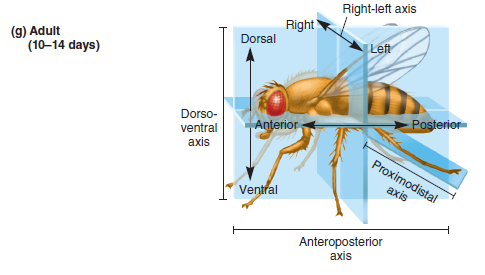
A. Along the anteroposterior axis, the head is posterior to the tail.
B. Along the dorsoventral axis, the vertebrae of the back are dorsal to the stomach.
C. Along the dorsoventral axis, the feet are dorsal to the hips.
D. Along the proximodistal axis, the feet on the hind legs are distal to the upper parts of the hind legs.
FIGURE 25.5 Developmental stages of the fruit fly Drosophila. (g) Adult.


Unlock Deck
Unlock for access to all 46 flashcards in this deck.
Unlock Deck
k this deck
5
Compare and contrast the experimental advantages of Drosophila and C. elegans in the study of developmental genetics.

Unlock Deck
Unlock for access to all 46 flashcards in this deck.
Unlock Deck
k this deck
6
It seems that developmental genetics boils down to a complex network of gene regulation. Try to draw how this network is structured for Drosophila. How many genes do you think are necessary to describe a complete developmental network for the fruit fly How many genes do you think are needed for a network to specify one segment Do you think it is more difficult to identify genes that are involved in the beginning, middle, or end of this network Knowing what you know about Drosophila development, suppose you were trying to identify all of the genes needed for development in a chicken. Would you first try to identify genes necessary for early development, or would you begin by identifying genes involved in cell differentiation

Unlock Deck
Unlock for access to all 46 flashcards in this deck.
Unlock Deck
k this deck
7
If you observed fruit flies with the following developmental abnormalities, would you guess that a mutation has occurred in a segmentation gene or a homeotic gene Explain your guess.
A. Three abdominal segments were missing.
B. One abdominal segment had legs.
C. A fly with the correct number of segments had two additional thoracic segments and two fewer abdominal segments.
A. Three abdominal segments were missing.
B. One abdominal segment had legs.
C. A fly with the correct number of segments had two additional thoracic segments and two fewer abdominal segments.

Unlock Deck
Unlock for access to all 46 flashcards in this deck.
Unlock Deck
k this deck
8
What is meant by the term cell fate What is a cell lineage diagram Discuss the experimental advantage of having a cell lineage diagram. What is a cell lineage

Unlock Deck
Unlock for access to all 46 flashcards in this deck.
Unlock Deck
k this deck
9
At the molecular level, how do you think a gain-of-function mutation in a developmental gene might cause it to be expressed in the wrong place or at the wrong time Explain what type of DNA sequence would be altered.

Unlock Deck
Unlock for access to all 46 flashcards in this deck.
Unlock Deck
k this deck
10
Which of the following statement(s) is/are true with regard to positional information in Drosophila
A. Morphogens are a type of molecule that conveys positional information.
B. Morphogenetic gradients are established only in the oocyte, prior to fertilization.
C. Cell adhesion molecules also provide a way for a cell to obtain positional information.
A. Morphogens are a type of molecule that conveys positional information.
B. Morphogenetic gradients are established only in the oocyte, prior to fertilization.
C. Cell adhesion molecules also provide a way for a cell to obtain positional information.

Unlock Deck
Unlock for access to all 46 flashcards in this deck.
Unlock Deck
k this deck
11
Explain why a cell lineage diagram is necessary to determine if a mutation is heterochronic.

Unlock Deck
Unlock for access to all 46 flashcards in this deck.
Unlock Deck
k this deck
12
Discuss the morphological differences between the parasegments and segments of Drosophila. Discuss the evidence, providing specific examples, that suggests the parasegments of the embryo are the subdivisions for the organization of gene expression.

Unlock Deck
Unlock for access to all 46 flashcards in this deck.
Unlock Deck
k this deck
13
Explain the rationale behind the use of the "bag of worms" phenotype as a way to identify heterochronic mutations.

Unlock Deck
Unlock for access to all 46 flashcards in this deck.
Unlock Deck
k this deck
14
Here are schematic diagrams of mutant larvae.

The left side of each pair shows a wild-type larva, with gray boxes showing the sections that are missing in the mutant larva. Which type of gene is defective in each larva: a gap gene, a pair-rule gene, or a segment-polarity gene

The left side of each pair shows a wild-type larva, with gray boxes showing the sections that are missing in the mutant larva. Which type of gene is defective in each larva: a gap gene, a pair-rule gene, or a segment-polarity gene

Unlock Deck
Unlock for access to all 46 flashcards in this deck.
Unlock Deck
k this deck
15
Here are the results of cell lineage analyses of hypodermal cells in wild-type and mutant strains of C. elegans.
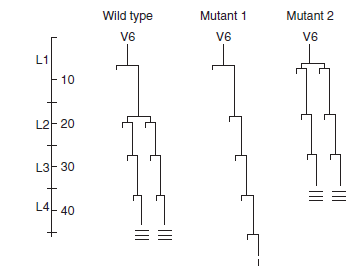
Explain the nature of the mutations in the altered strains.

Explain the nature of the mutations in the altered strains.

Unlock Deck
Unlock for access to all 46 flashcards in this deck.
Unlock Deck
k this deck
16
Describe what a morphogen is and how it exerts its effects. What do you expect will happen when a morphogen is expressed in the wrong place in an embryo List five examples of morphogens that function in Drosophila.

Unlock Deck
Unlock for access to all 46 flashcards in this deck.
Unlock Deck
k this deck
17
Take a look at solved problem S3 before answering this question. Drosophila embryos carrying a ts mutation were exposed to the permissive (25°C) or nonpermissive (30°C) temperature at different stages of development. Explain these results.

Problem S3
Mutations in genes that control the early stages of development are often lethal (e.g., see Figure 25.7b). To circumvent this problem, developmental geneticists may try to isolate temperature-sensitive developmental mutants, or ts alleles. If an embryo carries a ts allele, it will develop correctly at the permissive temperature (e.g., 25°C) but will fail to develop if incubated at the nonpermissive temperature (e.g., 30°C). In most cases, ts alleles are missense mutations that slightly alter the amino acid sequence of a protein, causing a change in its structure that prevents it from working properly at the nonpermissive temperature. ts alleles are particularly useful because they can provide insight regarding the stage of development when the protein encoded by the gene is necessary. Researchers can take groups of embryos that carry a ts allele and expose them to the permissive and nonpermissive temperature at different stages of development. In the experiment described next, embryos were divided into five groups and exposed to the permissive or nonpermissive temperature at different times after fertilization.
FIGURE 25.7 The bicoid mutation in Drosophila. (b) A larva from a homozygous bicoid mother in which both ends of the larva develop posterior structures. For example, both ends develop a spiracle, which normally is found only at the posterior end. This is a lethal condition.
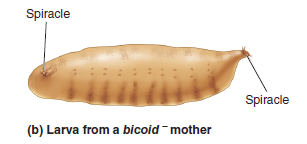
Explain these results.

Problem S3
Mutations in genes that control the early stages of development are often lethal (e.g., see Figure 25.7b). To circumvent this problem, developmental geneticists may try to isolate temperature-sensitive developmental mutants, or ts alleles. If an embryo carries a ts allele, it will develop correctly at the permissive temperature (e.g., 25°C) but will fail to develop if incubated at the nonpermissive temperature (e.g., 30°C). In most cases, ts alleles are missense mutations that slightly alter the amino acid sequence of a protein, causing a change in its structure that prevents it from working properly at the nonpermissive temperature. ts alleles are particularly useful because they can provide insight regarding the stage of development when the protein encoded by the gene is necessary. Researchers can take groups of embryos that carry a ts allele and expose them to the permissive and nonpermissive temperature at different stages of development. In the experiment described next, embryos were divided into five groups and exposed to the permissive or nonpermissive temperature at different times after fertilization.
FIGURE 25.7 The bicoid mutation in Drosophila. (b) A larva from a homozygous bicoid mother in which both ends of the larva develop posterior structures. For example, both ends develop a spiracle, which normally is found only at the posterior end. This is a lethal condition.

Explain these results.

Unlock Deck
Unlock for access to all 46 flashcards in this deck.
Unlock Deck
k this deck
18
What is the meaning of positional information Discuss three different ways that cells obtain positional information. Which of these three ways do you think is the most important for the formation of a segmented body pattern in Drosophila

Unlock Deck
Unlock for access to all 46 flashcards in this deck.
Unlock Deck
k this deck
19
All of the homeotic genes in Drosophila have been cloned. As discussed in Chapter 18, cloned genes can be manipulated in vitro. They can be subjected to cutting and pasting, site-directed mutagenesis, etc. After Drosophila genes have been altered in vitro, they can be inserted into a Drosophila transposon vector (i.e., a P element vector), and then the genetic construct containing the altered gene within a P element can be injected into Drosophila embryos. The P element then transposes into the chromosomes, thereby introducing one or more copies of the altered gene into the Drosophila genome. This method is termed P element transformation.
With these ideas in mind, how would you make a mutant gene with a "gain-of-function" in which the Antp gene would be expressed where the abd-A gene is normally expressed What phenotype would you expect for flies that carried this altered gene
With these ideas in mind, how would you make a mutant gene with a "gain-of-function" in which the Antp gene would be expressed where the abd-A gene is normally expressed What phenotype would you expect for flies that carried this altered gene

Unlock Deck
Unlock for access to all 46 flashcards in this deck.
Unlock Deck
k this deck
20
Gradients of morphogens can be preestablished in the oocyte. Also, later in development, morphogens can be secreted from cells. How are these two processes similar and different

Unlock Deck
Unlock for access to all 46 flashcards in this deck.
Unlock Deck
k this deck
21
You need to understand solved problem S4 before answering this question. If the artificial gene containing the stripe 2 enhancer and the -galactosidase gene was found within an embryo that also contained the following loss-of-function mutations, what results would you expect In other words, would there be a stripe or not Explain why.
A. Krüppel
B. bicoid
C. hunchback
D. giant
Solved Problem S4
An intriguing question in developmental genetics is, how can a particular gene, such as even-skipped, be expressed in a multiple banding pattern as seen in Figure 25.11 Another way of asking this question is, how is the positional information within the broad bands of the gap genes able to be deciphered in a way that causes the pair-rule genes to be expressed in this alternating banding pattern The answer lies in a complex mechanism of genetic regulation. Certain pair-rule genes have several stripe-specific enhancers that are controlled by multiple transcription factors. A stripe-specific enhancer is typically a short segment of DNA, 300-500 bp in length, that contains binding sequences recognized by several different transcription factors. This term is a bit misleading because a stripe-specific enhancer is a regulatory region that contains both enhancer and silencer elements.
In 1992, Michael Levine and his colleagues investigated stripe-specific enhancers located near the promoter of the even-skipped gene. A segment of DNA, termed the stripe 2 enhancer, controls the expression of the even-skipped gene; this enhancer is responsible for the expression of the even-skipped gene in stripe 2, which corresponds to parasegment 3 of the embryo. The stripe 2 enhancer is a segment of DNA that contains binding sites for four transcription factors that are the products of the Krüppel, bicoid, hunchback, and giant genes. The Hunchback and Bicoid transcription factors bind to this enhancer and activate the transcription of the even-skipped gene. In contrast, the transcription factors encoded by the Krüppel and giant genes bind to the stripe 2 enhancer and repress transcription. The figure shown next describes the concentrations of these four transcription factor proteins in the region of parasegment 3 (i.e., stripe 2) in the Drosophila embryo.
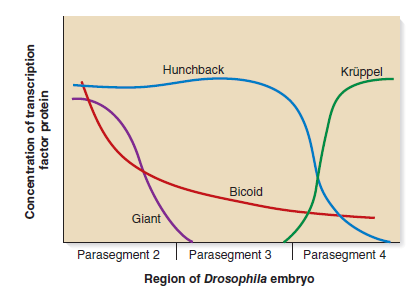
To study stripe-specific enhancers, researchers have constructed artificial genes in which the enhancer is linked to a reporter gene, the expression of which is easy to detect. The next figure shows the results of an experiment in which an artificial gene was made by putting the stripe 2 enhancer next to the -galactosidase gene. This artificial gene was introduced into Drosophila, and then embryos containing this gene were analyzed for -galactosidase activity. If a region of the embryo is expressing -galactosidase, the region will stain darkly because -galactosidase converts a colorless compound into a dark blue compound.
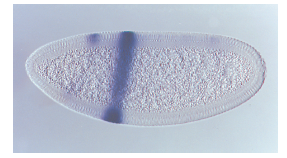
Explain these results.
FIGURE 25.11 Overview of the genetic hierarchy leading to segmentation in Drosophila. Note: When comparing steps 3 and 4, the elongated embryo bends in the middle and folds back on itself.
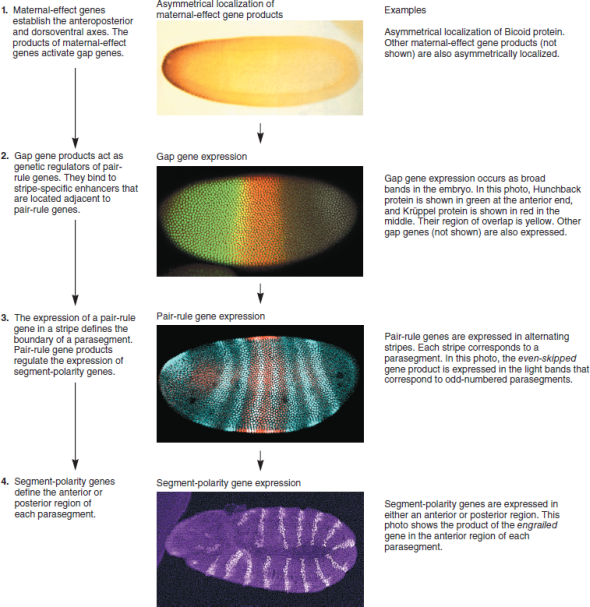
A. Krüppel
B. bicoid
C. hunchback
D. giant
Solved Problem S4
An intriguing question in developmental genetics is, how can a particular gene, such as even-skipped, be expressed in a multiple banding pattern as seen in Figure 25.11 Another way of asking this question is, how is the positional information within the broad bands of the gap genes able to be deciphered in a way that causes the pair-rule genes to be expressed in this alternating banding pattern The answer lies in a complex mechanism of genetic regulation. Certain pair-rule genes have several stripe-specific enhancers that are controlled by multiple transcription factors. A stripe-specific enhancer is typically a short segment of DNA, 300-500 bp in length, that contains binding sequences recognized by several different transcription factors. This term is a bit misleading because a stripe-specific enhancer is a regulatory region that contains both enhancer and silencer elements.
In 1992, Michael Levine and his colleagues investigated stripe-specific enhancers located near the promoter of the even-skipped gene. A segment of DNA, termed the stripe 2 enhancer, controls the expression of the even-skipped gene; this enhancer is responsible for the expression of the even-skipped gene in stripe 2, which corresponds to parasegment 3 of the embryo. The stripe 2 enhancer is a segment of DNA that contains binding sites for four transcription factors that are the products of the Krüppel, bicoid, hunchback, and giant genes. The Hunchback and Bicoid transcription factors bind to this enhancer and activate the transcription of the even-skipped gene. In contrast, the transcription factors encoded by the Krüppel and giant genes bind to the stripe 2 enhancer and repress transcription. The figure shown next describes the concentrations of these four transcription factor proteins in the region of parasegment 3 (i.e., stripe 2) in the Drosophila embryo.

To study stripe-specific enhancers, researchers have constructed artificial genes in which the enhancer is linked to a reporter gene, the expression of which is easy to detect. The next figure shows the results of an experiment in which an artificial gene was made by putting the stripe 2 enhancer next to the -galactosidase gene. This artificial gene was introduced into Drosophila, and then embryos containing this gene were analyzed for -galactosidase activity. If a region of the embryo is expressing -galactosidase, the region will stain darkly because -galactosidase converts a colorless compound into a dark blue compound.

Explain these results.
FIGURE 25.11 Overview of the genetic hierarchy leading to segmentation in Drosophila. Note: When comparing steps 3 and 4, the elongated embryo bends in the middle and folds back on itself.


Unlock Deck
Unlock for access to all 46 flashcards in this deck.
Unlock Deck
k this deck
22
Discuss how the anterior portion of the anteroposterior axis is established. What aspects of oogenesis are critical in establishing this axis What do you think would happen if the bicoid mRNA was not trapped at the anterior end but instead diffused freely throughout the oocyte

Unlock Deck
Unlock for access to all 46 flashcards in this deck.
Unlock Deck
k this deck
23
Two techniques commonly used to study the expression patterns of genes that play a role in development are Northern blotting and in situ hybridization. As described in Chapter 18, Northern blotting can be used to detect RNA that is transcribed from a particular gene. In this method, a specific RNA is detected by using a short segment of cloned DNA as a probe. The DNA probe, which is radioactive, is complementary to the RNA that the researcher wishes to detect. After the radioactive probe DNA binds to the RNA within a blot of a gel, the RNA is visualized as a dark (radioactive) band on an X-ray film. For example, a DNA probe that is complementary to the bicoid mRNA could be used to specifically detect the amount and size of the mRNA in a blot.
A second technique, termed fluorescence in situ hybridization (FISH), can be used to identify the locations of genes on chromosomes. This technique can also be used to locate gene products within oocytes, embryos, and larvae. For this reason, it has been commonly used by developmental geneticists to understand the expression patterns of genes during development. The micrograph in Figure 23.8b is derived from the application of the FISH technique. In this case, the probe was complementary to bicoid mRNA.
Now here is the question. Suppose a researcher has three different Drosophila strains that have loss-of-function mutations in the bicoid gene. We will call them bicoid-A , bicoid-B , and bicoid-C; the wild type is designated bicoid +. To study these mutations, phenotypically normal female flies that are homozygous for the bicoid mutation were obtained, and their oocytes were analyzed using these two techniques. A wild-type strain was also analyzed as a control. In other words, RNA was isolated from some oocytes and analyzed by Northern blotting, and some oocytes were subjected to in situ hybridization. In both cases, the probe was complementary to the bicoid mRNA. The results are shown on the next page.
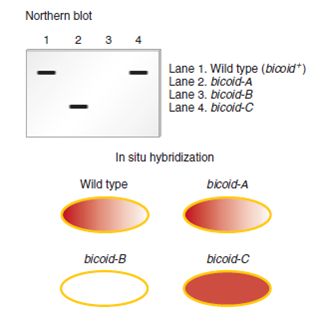
A. How can phenotypically normal female flies be homozygous for a loss-of-function allele in the bicoid gene
B. Explain the type of mutation (e.g., deletion, point mutation, etc.) in each of the three strains. Explain how the mutation may cause a loss of normal function for the bicoid gene product.
C. Discuss how the use of both techniques provides more definitive information than the application of just one of the two techniques.
A second technique, termed fluorescence in situ hybridization (FISH), can be used to identify the locations of genes on chromosomes. This technique can also be used to locate gene products within oocytes, embryos, and larvae. For this reason, it has been commonly used by developmental geneticists to understand the expression patterns of genes during development. The micrograph in Figure 23.8b is derived from the application of the FISH technique. In this case, the probe was complementary to bicoid mRNA.
Now here is the question. Suppose a researcher has three different Drosophila strains that have loss-of-function mutations in the bicoid gene. We will call them bicoid-A , bicoid-B , and bicoid-C; the wild type is designated bicoid +. To study these mutations, phenotypically normal female flies that are homozygous for the bicoid mutation were obtained, and their oocytes were analyzed using these two techniques. A wild-type strain was also analyzed as a control. In other words, RNA was isolated from some oocytes and analyzed by Northern blotting, and some oocytes were subjected to in situ hybridization. In both cases, the probe was complementary to the bicoid mRNA. The results are shown on the next page.

A. How can phenotypically normal female flies be homozygous for a loss-of-function allele in the bicoid gene
B. Explain the type of mutation (e.g., deletion, point mutation, etc.) in each of the three strains. Explain how the mutation may cause a loss of normal function for the bicoid gene product.
C. Discuss how the use of both techniques provides more definitive information than the application of just one of the two techniques.

Unlock Deck
Unlock for access to all 46 flashcards in this deck.
Unlock Deck
k this deck
24
Describe the function of the Bicoid protein. Explain how its ability to exert its effects in a concentration-dependent manner is a critical feature of its function.

Unlock Deck
Unlock for access to all 46 flashcards in this deck.
Unlock Deck
k this deck
25
Explain one experimental strategy for determining the functional role of the mouse HoxD-3 gene.

Unlock Deck
Unlock for access to all 46 flashcards in this deck.
Unlock Deck
k this deck
26
With regard to development, what are the roles of the maternal-effect genes versus the zygotic genes Which types of genes are needed earlier in the development process

Unlock Deck
Unlock for access to all 46 flashcards in this deck.
Unlock Deck
k this deck
27
In the experiment of Figure 25.16, suggest reasons why the n536, n355, and n540 strains have an egg-laying defect.
FIGURE 25.16 Identification of mutations that affect the timing of development in C. elegans.
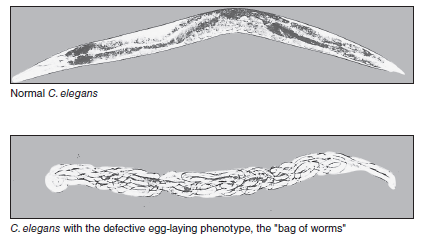
FIGURE 25.16 Identification of mutations that affect the timing of development in C. elegans.


Unlock Deck
Unlock for access to all 46 flashcards in this deck.
Unlock Deck
k this deck
28
Discuss the role of homeotic genes in development. Explain what happens to the phenotype of a fly when a gain-of-function homeotic gene mutation occurs in an abnormal region of the embryo. What are the consequences of a loss-of-function mutation in such a gene

Unlock Deck
Unlock for access to all 46 flashcards in this deck.
Unlock Deck
k this deck
29
Another way to study the role of proteins (e.g., transcription factors) that function in development is to microinject the mRNA that encodes a protein, or the purified protein itself, into an oocyte or embryo, and then determine how this affects the subsequent development of the embryo, larva, and adult. For example, if Bicoid protein is injected into the posterior region of an oocyte, the resulting embryo will develop into a larva that has anterior structures at both ends. Based on your understanding of the function of these developmental genes, what would be the predicted phenotype if the following proteins or mRNAs were injected into normal oocytes
A. Nanos mRNA injected into the anterior end of an oocyte
B. Antp protein injected into the posterior end of an embryo
C. Toll mRNA injected into the dorsal side of an early embryo
A. Nanos mRNA injected into the anterior end of an oocyte
B. Antp protein injected into the posterior end of an embryo
C. Toll mRNA injected into the dorsal side of an early embryo

Unlock Deck
Unlock for access to all 46 flashcards in this deck.
Unlock Deck
k this deck
30
Describe the molecular features of the homeobox and homeodo-main. Explain how these features are important in the function of homeotic genes.

Unlock Deck
Unlock for access to all 46 flashcards in this deck.
Unlock Deck
k this deck
31
Why have geneticists used reverse genetics to study the genes involved in vertebrate development Explain how this strategy differs from traditional genetic analyses like those done by Mendel.

Unlock Deck
Unlock for access to all 46 flashcards in this deck.
Unlock Deck
k this deck
32
What would you predict to be the phenotype of a Drosophila larva whose mother was homozygous for a loss-of-function allele in the nanos gene

Unlock Deck
Unlock for access to all 46 flashcards in this deck.
Unlock Deck
k this deck
33
Based on the photographs in Figure 25.13, in which segments would the Antp gene normally be expressed
FIGURE 25.13 The Antennapedia mutation in Drosophila.
Genes Traits (a) A normal fly with antennae. (b) This mutant fly has a gain-of-function mutation in which the Antp gene is expressed in the embryonic segment that normally gives rise to antennae. The expression of Antp causes this region to have legs rather than antennae.
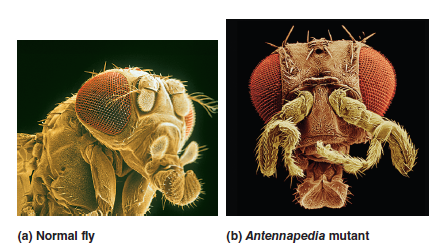
FIGURE 25.13 The Antennapedia mutation in Drosophila.
Genes Traits (a) A normal fly with antennae. (b) This mutant fly has a gain-of-function mutation in which the Antp gene is expressed in the embryonic segment that normally gives rise to antennae. The expression of Antp causes this region to have legs rather than antennae.


Unlock Deck
Unlock for access to all 46 flashcards in this deck.
Unlock Deck
k this deck
34
If a mutation in a homeotic gene produced the following phenotypes, would you expect the mutation to be a loss-of-function or a gain-of-function allele Explain your answer.
A. An abdominal segment has antennae attached to it.
B. The most anterior abdominal segment resembles the most posterior thoracic segment.
C. The most anterior thoracic segment resembles the most posterior abdominal segment.
A. An abdominal segment has antennae attached to it.
B. The most anterior abdominal segment resembles the most posterior thoracic segment.
C. The most anterior thoracic segment resembles the most posterior abdominal segment.

Unlock Deck
Unlock for access to all 46 flashcards in this deck.
Unlock Deck
k this deck
35
Explain how loss-of-function mutations in the following categories of genes would affect the morphologies of Drosophila larvae:
A. Gap genes
B. Pair-rule genes
C. Segment-polarity genes
A. Gap genes
B. Pair-rule genes
C. Segment-polarity genes

Unlock Deck
Unlock for access to all 46 flashcards in this deck.
Unlock Deck
k this deck
36
What is the difference between a maternal-effect gene and a zygotic gene Of the following genes that play a role in Drosophila development, which are maternal-effect genes and which are zygotic Explain your answer.
A. nanos
B. Antp
C. bicoid
D. lab
A. nanos
B. Antp
C. bicoid
D. lab

Unlock Deck
Unlock for access to all 46 flashcards in this deck.
Unlock Deck
k this deck
37
Cloning of mammals (such as Dolly) is described in Chapter 21. Based on your understanding of animal development, explain why an enucleated egg is needed to clone mammals. In other words, what features of the oocyte are essential for animal development

Unlock Deck
Unlock for access to all 46 flashcards in this deck.
Unlock Deck
k this deck
38
A hypothetical cell lineage is shown here.
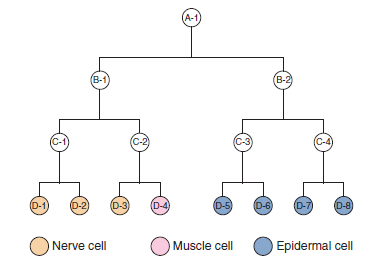
A gene, which we will call gene X, is activated in the B-1 cell, so the B-1 cell will progress through the proper developmental stages to produce three nerve cells (D-1, D-2, and D-3) and one muscle cell (D-4). Gene X is normally inactivated in A-1, C-1, and C-2 cells, as well as the four D cells. Draw the expected cell lineages if a heterochronic mutation had the following effects:
A. Gene X is turned on one cell division too early.
B. Gene X is turned on one cell division too late.

A gene, which we will call gene X, is activated in the B-1 cell, so the B-1 cell will progress through the proper developmental stages to produce three nerve cells (D-1, D-2, and D-3) and one muscle cell (D-4). Gene X is normally inactivated in A-1, C-1, and C-2 cells, as well as the four D cells. Draw the expected cell lineages if a heterochronic mutation had the following effects:
A. Gene X is turned on one cell division too early.
B. Gene X is turned on one cell division too late.

Unlock Deck
Unlock for access to all 46 flashcards in this deck.
Unlock Deck
k this deck
39
What is a heterochronic mutation How does it affect the phenotypic outcome of an organism What phenotypic effects would you expect if a heterochronic mutation affected the cell lineage that determines the fates of intestinal cells

Unlock Deck
Unlock for access to all 46 flashcards in this deck.
Unlock Deck
k this deck
40
Discuss the similarities and differences between the bithorax and Antennapedia complexes in Drosophila and the Hox gene complexes in mice.

Unlock Deck
Unlock for access to all 46 flashcards in this deck.
Unlock Deck
k this deck
41
What is cell differentiation Discuss the role of myogenic bHLH proteins in the differentiation of muscle cells. Explain how they work at the molecular level. In your answer, indicate how protein dimerization is a key feature in gene regulation.

Unlock Deck
Unlock for access to all 46 flashcards in this deck.
Unlock Deck
k this deck
42
The MyoD gene in mammals plays a role in skeletal muscle-cell differentiation, whereas the Hox genes are homeotic genes that play a role in the differentiation of particular regions of the body. Explain how the functions of these genes are similar and different.

Unlock Deck
Unlock for access to all 46 flashcards in this deck.
Unlock Deck
k this deck
43


Unlock Deck
Unlock for access to all 46 flashcards in this deck.
Unlock Deck
k this deck
44
What is a meristem Explain the role of meristems in plant development.

Unlock Deck
Unlock for access to all 46 flashcards in this deck.
Unlock Deck
k this deck
45
Discuss the morphological differences between animal and plant development. How are they different at the cellular level How are they similar at the genetic level

Unlock Deck
Unlock for access to all 46 flashcards in this deck.
Unlock Deck
k this deck
46
Predict the phenotypic consequences of each of the following mutations:
A. apetala1 defective
B. pistillata defective
C. apetala1 and pistillata defective
A. apetala1 defective
B. pistillata defective
C. apetala1 and pistillata defective

Unlock Deck
Unlock for access to all 46 flashcards in this deck.
Unlock Deck
k this deck



